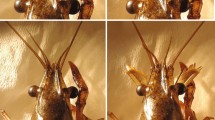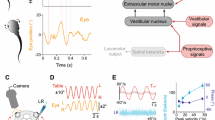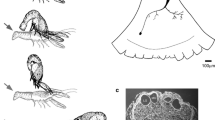Abstract
This work studies the tail and eye co-ordinated movements evoked by the focal electrical stimulation of the tectum in goldfish. The aim of the study is to understand better those tectal sites and mechanisms that either remain functionally unaltered or are adaptively modified across vertebrates. Stimulation was applied in various tectal zones, and the characteristics of evoked tail and eye movements were examined as a function of the stimulation site over tectal surface and the stimulus parameters. Two types of response were electrically evoked: the former turned the body and the eyes contraversively towards the source of natural stimulus; the second produced initial ipsiversive turning of the body and eyes, followed by several tail beats. Evoking one or other response depended on both the site and parameters of stimulation, and responses were interpreted as orienting- and escape-like, respectively. Depending on the stimulation site, four different zones in the tectum were distinguished: in the medial zone the stimulus elicited eye and tail movements whose size increased with the distance to the rostral pole. The stimulation of the antero-medial zone evoked contraversive or ipsiversive eye saccades but tail movements were similar, irrespective of eye movements. Stimulation within the extreme antero-medial zone evoked convergent eye movements, and tail displacements turning the body either ipsiversively or contraversively. Stimulation of the posterior zone often evoked complex tail movements and pure horizontal eye saccades. Both orienting- and escape-like responses were also dependent on the stimulus parameters. The relationships between stimulus parameters and tail- and eye-orienting movement characteristics suggest that the velocity and duration might be encoded in different aspects of the tectal activity. Current strength also modified the number of tail beats that appeared during escape-like response. In conclusion, the present data suggest the involvement of the optic tectum not only in orienting but also in escape responses and that movements of eye and tail mediating such responses depend on the tectal active locus together with its level of activity.
Similar content being viewed by others
Author information
Authors and Affiliations
Additional information
Received: 24 September 1997 / Accepted: 4 December 1997
Rights and permissions
About this article
Cite this article
Herrero, L., Rodríguez, F., Salas, C. et al. Tail and eye movements evoked by electrical microstimulation of the optic tectum in goldfish. Exp Brain Res 120, 291–305 (1998). https://doi.org/10.1007/s002210050403
Issue Date:
DOI: https://doi.org/10.1007/s002210050403




